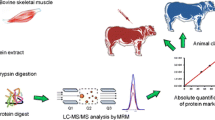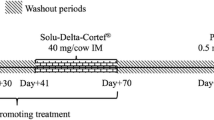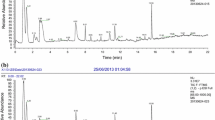Abstract
Growth-promoting agents are continually misused for increasing animal growth and fraudulent gain in the meat industry, yet detection rates from conventional targeted testing for drug residues do not reflect this. This is because testing currently relies on direct detection of drugs or related metabolites and administrators of such compounds can take adaptive measures to avoid detection through the use of endogenous or unknown drugs, and low dose or combined mixtures. New detection methods are needed which focus on the screening of biological responses of an animal to such growth-promoting agents as it has been demonstrated that genomic, proteomic and metabolomics profiles are altered by xenobiotic intake. Therefore, an untargeted proteomics approach using comparative two-dimensional gel electrophoresis (2DE) was carried out to identify putative proteins altered in plasma after treatment with oestradiol, dexamethasone or prednisolone. Twenty-four male cattle were randomly assigned to four groups (n = 6) for experimental treatment over 40 days, namely a control group of non-treated cattle, and three groups administered 17β-oestradiol-3-benzoate (0.01 mg/kg, intramuscular), dexamethasone sodium phosphate (0.7 mg/day, per os) or prednisolone acetate (15 mg/day, per os), respectively. Plasma collected from each animal at day 25 post study initiation was subjected to proteomic analysis by 2DE for comparison of protein expression between treated and untreated animals. Analysis of acquired gel images revealed 22 plasma proteins which differed in expression by more than 50 % (p < 0.05) in treated animals compared to untreated animals. Proteins of interest underwent identification by LC–MS/MS analysis and were found to have associated roles in transport, blood coagulation, immune response and metabolism pathways. In this way, seven proteins are highlighted as novel biomarker candidates including transthyretin which is shown to be significantly increased in all treatment groups compared to control animals and potentially may find use as global markers of suspect anabolic practice.





Similar content being viewed by others
References
Commission EU (2002) Commission Decision EC 2002/657 of 12 August 2002 implementing Council Directive 96/23/EC concerning the performance of analytical methods and the interpretation of results. Off J Eur Union L221
Stephany RW (2010) Hormonal growth promoting agents in food producing animals. Doping in sports: biochemical principles, effects and analysis. In: Thieme D, Hemmersbach P (eds) Handbook of experimental pharmacology, vol 195. Springer, Berlin, pp 355–67
Courtheyn D, Le Bizec B, Brambilla G, De Brabander H, Cobbaert E, Van de Wiele M, Vercammen J, De Wasch K (2002) Recent developments in the use and abuse of growth promoters. Anal Chim Acta 473(1):71–82
Mooney M, Situ C, Cacciatore G, Hutchinson T, Elliott C, Bergwerff A (2008) Plasma biomarker profiling in the detection of growth promoter use in calves. Biomarkers 13(3):246–56
Meyer HHD (2001) Biochemistry and physiology of anabolic hormones used for improvement of meat production. Apmis 109:S336–44
Commission EU (2002) Opinion of the Scientific Committee on Veterinary Measures relating to Public Health - review of previous SCVPH opinions of 30 April 1999 and 3 May 2000 on the potential risks to human health from hormone residues in bovine meat and meat products. Eur Comm Health Consum Prot Direct Gen C2:1–34
Commission EU (2003) Commission Directive (EU) No 2003/74/EC of 22 September 2003 amending Council Directive 96/22/EC concerning the prohibition on the use in stockfarming of certain substances having a hormonal or thyrostatic action and of beta-agonists. Off J Eur Union L262:17–21
Commission EU (2010) Commission Regulation (EU) No 37/2010 of 22 December 2009 on pharmacologically active substances and their classification regarding maximum residue limits in foodstuffs of animal origin. Off J Eur Union L53:15–1
Tarantola M, Schiavone A, Preziuso G, Russo C, Biolatti B, Bergero D (2004) Effects of low doses of dexamethasone on productive traits and meat quality of veal calves. Anim Sci 79(1):93–8
Cantiello M, Giantin M, Carletti M, Lopparelli RM, Capolongo F, Lasserre F, Bollo E, Dacasto M (2009) Effects of dexamethasone, administered for growth promoting purposes, upon the hepatic cytochrome P450 3A expression in the veal calf. Biochem Pharmacol 77(3):451–63
Odore R, Badino P, Pagliasso S, Nebbia C, Cuniberti B, Barbero R, Re G (2006) Changes in lymphocyte glucocorticoid and β-adrenergic receptors in veal calves treated with clenbuterol and steroid hormones for growth-promoting purposes. J Vet Pharmacol Ther 29(2):91–7
Pinel G, Weigel S, Antignac JP, Mooney M, Elliott C, Nielen M, Le Bizec B (2010) Targeted and untargeted profiling of biological fluids to screen for anabolic practices in cattle. Trends Anal Chem 29(11):1269–80
Rico AG (1983) Metabolism of endogenous and exogenous anabolic agents in cattle. J Anim Sci 57(1):226–32
Maume D, Le Bizec B, Pouponneau K, Deceuninck Y, Solere V, Paris A, Antignac JP, Andre F (2003) Modification of 17β-estradiol metabolite profile in steer edible tissues after estradiol implant administration. Anal Chim Acta 483(1):289–97
Cannizzo FT, Capra P, Divari S, Ciccotelli V, Biolatti B, Vincenti M (2011) Effects of low-dose dexamethasone and prednisolone long term administration in beef calf: chemical and morphological investigation. Anal Chim Acta 700(1):95–104
Vincenti M, Girolami F, Capra P, Pazzi M, Carletti M, Gardini G, Nebbia C (2009) Study of dexamethasone urinary excretion profile in cattle by LC- MS/MS: comparison between therapeutic and growth-promoting administration. J Agric Food Chem 57(4):1299–306
Ferranti C, Quadri F, Palleschi L, Marchiafava C, Pezzolato M, Bozzetta E, Caramelli M, Draisci R (2011) Studies on the presence of natural and synthetic corticosteroids in bovine urine. Steroids 76(6):616–62515
Bertocchi L, Dusi G, Ghidelli V, Hathaway T, Nassuato C, Casati A, Fidani M, Pompa G, Arioli F (2013) Investigation on the origin of prednisolone in urine and adrenal glands of cows. Food Addit Contam Part A 30(6):1055–62
Arioli F, Fidani M, Casati A, Fracchiolla ML, Pompa G (2010) Investigation on possible transformations of cortisol, cortisone and cortisol glucuronide in bovine faecal matter using liquid chromatography–mass spectrometry. Steroids 75(4):350–4
De Clercq N, Bussche JV, Croubels S, Delahaut P, Vanhaecke L (2014) Development and validation of a high-resolution mass-spectrometry–based method to study the long-term stability of natural and synthetic glucocorticoids in faeces. J Chromatogr A 1336:76–86
De Rijke E, Zoontjes PW, Samson D, Oostra S, Sterk SS, van Ginkel LA (2014) Investigation of the presence of prednisolone in bovine urine. Food Addit Contam Part A 31(4):605–13
Castagnaro M, Poppi L (2006) Indirect biomarkers of illegal anabolic treatments: five years of activity under the microscope. Vet Res Commun 30:105–8
Mooney MH, Bergwerff AA, van Meeuwen JA, Luppa PB, Elliott CT (2009) Biosensor-based detection of reduced sex hormone-binding globulin binding capacities in response to growth-promoter administrations. Anal Chim Acta 637(1):235–40
Ludwig SKJ, Smits NGE, Cannizzo FT, Nielen MWF (2013) Potential of treatment-specific protein biomarker profiles for detection of hormone abuse in cattle. J Agric Food Chem 61(19):4514–9
Cacciatore G, Eisenberg SWF, Situ C, Mooney MH, Delahaut P, Klarenbeek S, Huet AC, Bergwerff AA, Elliott CT (2009) Effect of growth-promoting 17β-estradiol, 19-nortestosterone and dexamethasone on circulating levels of nine potential biomarker candidates in veal calves. Anal Chim Acta 637(1):351–9
De Jager N, Hudson NJ, Reverter A, Wang YH, Nagaraj SH, Cafe LM, Greenwood PL, Barnard RT, Kongsuwa KP, Dalrymple BP (2011) Chronic exposure to anabolic steroids induces the muscle expression of oxytocin and a more than fiftyfold increase in circulating oxytocin in cattle. Physiol Genomics 43(9):467–78
Divari S, Cannizzo FT, Uslenghi F, Pregel P, Mulasso C, Spada F, De Maria R, Biolatti B (2011) Corticosteroid hormone receptors and prereceptors as new biomarkers of the illegal use of glucocorticoids in meat production. J Agric Food Chem 59(5):2120–5
Warder SE, Tucker LA, Strelitzer TJ, McKeegan EM, Meuth JL, Jung PM, Saraf A (2009) Reducing agent-mediated precipitation of high-abundance plasma proteins. Anal Biochem 387(2):184–93
Bradford MM (1976) A rapid and sensitive method for the quantitation of microgram quantities of protein utilizing the principle of protein-dye binding. Anal Biochem 72(1):248–54
Anderson N, Copple D, Bendele R, Probst G, Richardson F (1992) Covalent protein modifications and gene expression changes in rodent liver following administration of methapyrilene: a study using two-dimensional electrophoresis. Fundam Appl Toxicol 18(4):570–80
Shevchenko A, Tomas H, Havli J, Olsen JV, Mann M (2007) In-gel digestion for mass spectrometric characterization of proteins and proteomes. Nat Protoc 1(6):2856–2860
Rogowska-Wrzesinska A, Le Bihan MC, Thaysen-Andersen M, Roepstorff P (2013) 2D gels still have a niche in proteomics. J Proteomics 88:4–13
Marin A, Pozza G, Gottardo F, Moro L, Stefani A, Cozzi G, Brscic M, Andrighetto I, Ravarotto L (2008) Administration of dexamethasone per os in finishing bulls. II. Effects on blood parameters used as indicators of animal welfare. Animal 2(7):1080–6
McGrath TF, van Meeuwen JA, Massart AC, de Pauw E, Delahaut P, Buijs J, Berwerff AA, Elliott CT, Mooney MH (2013) Effect-based proteomic detection of growth promoter abuse. Anal Bioanal Chem 405(4):1171–9
Mitchell GB, Clark ME, Caswell JL (2007) Alterations in the bovine bronchoalveolar lavage proteome induced by dexamethasone. Vet Immunol Immunopathol 118(3):283–93
Epstein FH, Gabay C, Kushner I (1999) Acute-phase proteins and other systemic responses to inflammation. N Engl J Med 340(6):448–54
Salier J, Rouet P, Raguenez G, Daveau M (1996) The inter-alpha-inhibitor family: from structure to regulation. Biochem J 315:1–9
Stella R, Biancotto G, Krogh M, Angeletti R, Pozza G, Sorgato MC, James P, Andrighetto I (2011) Protein expression changes in skeletal muscle in response to growth promoter abuse in beef cattle. J Proteome Res 10(6):2744–57
Beagley KW, Gockel CM (2003) Regulation of innate and adaptive immunity by the female sex hormones oestradiol and progesterone. FEMS Immunol Med Microbiol 38(1):13–22
Plump AS, Erickson SK, Weng W, Partin JS, Breslow JL, Williams DL (1996) Apolipoprotein AI is required for cholesteryl ester accumulation in steroidogenic cells and for normal adrenal steroid production. J Clin Investig 97(11):2660
Draisci R, Montesissa C, Santamaria B, D'Ambrosio C, Ferretti G, Merlanti R, Ferranti C, Cosulich ME (2007) Integrated analytical approach in veal calves administered the anabolic androgenic steroids boldenone and boldione: urine and plasma kinetic profile and changes in plasma protein expression. Proteomics 7(17):3184–93
Della Donna L, Ronci M, Sacchetta P, Di Ilio C, Biolatti B, Federici G, Nebbia C, Urbani A (2009) A food safety control low mass-range proteomics platform for the detection of illicit treatments in veal calves by MALDI-TOF-MS serum profiling. Biotechnol J 4(11):1596–609
Barton C, Beck P, Kay R, Teale P, Roberts J (2009) Multiplexed LC-MS/MS analysis of horse plasma proteins to study doping in sport. Proteomics 9(11):3058–65
Ellenberger MA, Johnson D, Carstens G, Hossner K, Holland M, Nett T, Nockels C (1989) Endocrine and metabolic changes during altered growth rates in beef cattle. J Anim Sci 67(6):1446–54
Ding J, List EO, Okada S, Kopchick JJ (2009) Perspective: proteomic approach to detect biomarkers of human growth hormone. Growth Horm IGF Res 19(4):399–407
Berni R, Stoppini M, Zapponi MC, Melon ML, Monaco HL, Zanotti G (1990) The bovine plasma retinol-binding protein. Eur J Biochem 192(2):507–13
Pérez MD, Miguel C (1995) Interaction of β-lactoglobulin with retinol and fatty acids and its role as a possible biological function for this protein: a review. J Dairy Sci 78(5):978–88
Graf S, Egert S, Heer M (2011) Effects of whey protein supplements on metabolism: evidence from human intervention studies. Curr Opin Clin Nutr Metab Care 14(6):569–80
Baeke F, Takiishi T, Korf H, Gysemans C, Mathieu C (2010) Vitamin D: modulator of the immune system. Curr Opin Pharmacol 10(4):482–96
Acknowledgments
This work was financially supported by the UK Government Department for Employment and Learning, Northern Ireland (DELNI) through the Advanced ASSET centre with no conflict of interest imposed and all research was conducted under good laboratory practice.
Author information
Authors and Affiliations
Corresponding author
Additional information
Published in the topical collection on Hormone and Veterinary Drug Residue Analysis with guest editors Siska Croubels, Els Daeseleire, Sarah De Saeger, Peter Van Eenoo, and Lynn Vanhaecke.
Electronic supplementary material
Below is the link to the electronic supplementary material.
ESM 1
(PDF 268 kb)
Rights and permissions
About this article
Cite this article
Kinkead, R.A., Elliott, C.T., Cannizzo, F.T. et al. Proteomic identification of plasma proteins as markers of growth promoter abuse in cattle. Anal Bioanal Chem 407, 4495–4507 (2015). https://doi.org/10.1007/s00216-015-8651-0
Received:
Revised:
Accepted:
Published:
Issue Date:
DOI: https://doi.org/10.1007/s00216-015-8651-0




